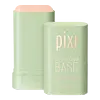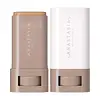Pixi Beauty On-The-Glow Base Foundation Moisture Stick Versus Anastasia Beverly Hills Beauty Balm Serum Boosted Skin Tint
What's inside
What's inside
 Key Ingredients
Key Ingredients

 Benefits
Benefits

 Concerns
Concerns

 Ingredients Side-by-side
Ingredients Side-by-side

Caprylic/Capric Triglyceride
MaskingDiisostearyl Malate
EmollientSynthetic Wax
AbrasivePolyglyceryl-2 Triisostearate
EmulsifyingTriethylhexanoin
MaskingBoron Nitride
AbsorbentCalcium Sodium Borosilicate
Kaolin
AbrasivePentaerythrityl Tetraisostearate
EmollientBis-Diglyceryl Polyacyladipate-2
EmollientRicinus Communis Seed Oil
MaskingHydrogenated Castor Oil
EmollientPhytosteryl/Isostearyl/Cetyl/Stearyl/Behenyl Dimer Dilinoleate
Skin ConditioningTocopheryl Acetate
Antioxidant1,2-Hexanediol
Skin ConditioningHippophae Rhamnoides Fruit Oil
Skin ProtectingTetrahexyldecyl Ascorbate
AntioxidantCeramide NP
Skin ConditioningSodium Hyaluronate
HumectantCitrus Limon Fruit Extract
MaskingFragaria Chiloensis Fruit Extract
Skin ConditioningCamellia Sinensis Leaf Extract
AntimicrobialVitis Vinifera Fruit Extract
Skin ConditioningPyrus Malus Fruit Extract
Skin ConditioningVaccinium Angustifolium Fruit Extract
Skin ProtectingRubus Idaeus Fruit Extract
AstringentAloe Barbadensis Leaf Extract
EmollientHamamelis Virginiana Extract
AntiseborrhoeicPanax Ginseng Root Extract
EmollientNonapeptide-1
Skin ConditioningSodium Phosphate
BufferingTocopherol
AntioxidantPhenoxyethanol
PreservativeZinc Oxide
Cosmetic ColorantIron Oxides
Caprylic/Capric Triglyceride, Diisostearyl Malate, Synthetic Wax, Polyglyceryl-2 Triisostearate, Triethylhexanoin, Boron Nitride, Calcium Sodium Borosilicate, Kaolin, Pentaerythrityl Tetraisostearate, Bis-Diglyceryl Polyacyladipate-2, Ricinus Communis Seed Oil, Hydrogenated Castor Oil, Phytosteryl/Isostearyl/Cetyl/Stearyl/Behenyl Dimer Dilinoleate, Tocopheryl Acetate, 1,2-Hexanediol, Hippophae Rhamnoides Fruit Oil, Tetrahexyldecyl Ascorbate, Ceramide NP, Sodium Hyaluronate, Citrus Limon Fruit Extract, Fragaria Chiloensis Fruit Extract, Camellia Sinensis Leaf Extract, Vitis Vinifera Fruit Extract, Pyrus Malus Fruit Extract, Vaccinium Angustifolium Fruit Extract, Rubus Idaeus Fruit Extract, Aloe Barbadensis Leaf Extract, Hamamelis Virginiana Extract, Panax Ginseng Root Extract, Nonapeptide-1, Sodium Phosphate, Tocopherol, Phenoxyethanol, Zinc Oxide, Iron Oxides
Caprylic/Capric Triglyceride
MaskingCoco-Caprylate/Caprate
EmollientEthylhexyl Isononanoate
EmollientTribehenin
EmollientC20-40 Alcohols
EmulsifyingButyrospermum Parkii Butter
Skin ConditioningCorn Starch Modified
AbsorbentPolyester-7
Skin ConditioningLauroyl Lysine
Skin ConditioningPolymethylsilsesquioxane
Simmondsia Chinensis Seed Oil
EmollientHdi/Trimethylol Hexyllactone Crosspolymer
Neopentyl Glycol Diheptanoate
EmollientSilica
AbrasivePolyethylene
AbrasiveCaprylyl Glycol
EmollientCocos Nucifera Oil
MaskingSclerocarya Birrea Seed Oil
HumectantLecithin
EmollientDipalmitoyl Hydroxyproline
Skin ConditioningAstrocaryum Murumuru Seed Butter
EmollientTocopheryl Acetate
AntioxidantHelianthus Annuus Seed Oil
EmollientPentaerythrityl Tetraisostearate
EmollientPalmitic Acid
EmollientRicinus Communis Seed Oil
MaskingSodium Hyaluronate
HumectantHydrogenated Castor Oil
EmollientPolygonum Aviculare Extract
EmollientWater
Skin ConditioningPropylene Carbonate
SolventStearalkonium Hectorite
Gel FormingPalmitoyl Tripeptide-1
Skin ConditioningTocopherol
AntioxidantCI 77891
Cosmetic ColorantIron Oxides
Caprylic/Capric Triglyceride, Coco-Caprylate/Caprate, Ethylhexyl Isononanoate, Tribehenin, C20-40 Alcohols, Butyrospermum Parkii Butter, Corn Starch Modified, Polyester-7, Lauroyl Lysine, Polymethylsilsesquioxane, Simmondsia Chinensis Seed Oil, Hdi/Trimethylol Hexyllactone Crosspolymer, Neopentyl Glycol Diheptanoate, Silica, Polyethylene, Caprylyl Glycol, Cocos Nucifera Oil, Sclerocarya Birrea Seed Oil, Lecithin, Dipalmitoyl Hydroxyproline, Astrocaryum Murumuru Seed Butter, Tocopheryl Acetate, Helianthus Annuus Seed Oil, Pentaerythrityl Tetraisostearate, Palmitic Acid, Ricinus Communis Seed Oil, Sodium Hyaluronate, Hydrogenated Castor Oil, Polygonum Aviculare Extract, Water, Propylene Carbonate, Stearalkonium Hectorite, Palmitoyl Tripeptide-1, Tocopherol, CI 77891, Iron Oxides
Ingredients Explained
These ingredients are found in both products.
Ingredients higher up in an ingredient list are typically present in a larger amount.
This ingredient is an emollient, solvent, and texture enhancer. It is considered a skin-softener by helping the skin prevent moisture loss.
It helps thicken a product's formula and makes it easier to spread by dissolving clumping compounds.
Caprylic Triglyceride is made by combining glycerin with coconut oil, forming a clear liquid.
While there is an assumption Caprylic Triglyceride can clog pores due to it being derived from coconut oil, there is no research supporting this.
Learn more about Caprylic/Capric TriglycerideHydrogenated Castor Oil is created by adding hydrogen to castor oil. This helps stabilize the castor oil and raises the melting point. At room temperature, hydrogenated castor oil is solid.
Castor Oil helps moisturize the skin. It is rich in a fatty acid called ricinoleic acid. This fatty acid helps prevent moisture loss on the skin. This helps keep your skin soft and hydrated. Ricinoleic acid also has anti-inflammatory and pain reducing properties.
As a wax-like substance, Hydrogenated Castor Oil acts as an emollient. Emollients help keep your skin stay soft and smooth by creating a barrier. This barrier helps trap moisture.
Hydrogenated Castor Oil may not be fungal-acne safe. We recommend speaking with a professional.
Learn more about Hydrogenated Castor OilPentaerythrityl Tetraisostearate is derived from isostearic acid. It is an emollient and emulsifier.
The highest concentration of this ingredient is found in lipsticks.
This ingredient is minimally water soluble and may not be Malassezia folliculitis, or fungal-acne safe.
Learn more about Pentaerythrityl TetraisostearateRicinus Communis Seed Oil is the INCI name for castor oil.
Castor Oil helps moisturize the skin. It is rich in a fatty acid called ricinoleic acid. This fatty acid helps prevent moisture loss on the skin. This helps keep your skin soft and hydrated. Ricinoleic acid also has anti-inflammatory and pain reducing properties.
Besides hydrating the skin, castor oil is also used to hydrate hair. By keeping the hair shaft moisturized, breakage is decreased. More studies are needed to show castor oil's effective on stimulating hair growth.
Castor oil is created by cold-pressing castor seeds and then purifying the oil with heat. It was used in Ancient Egypt as fuel in lamps and to help treat eye irritation.
The term 'fragrance' is not regulated in many countries. In many cases, it is up to the brand to define this term. For instance, many brands choose to label themselves as "fragrance-free" because they are not using synthetic fragrances. However, their products may still contain ingredients such as essential oils that are considered a fragrance.
Learn more about Ricinus Communis Seed OilSodium Hyaluronate is hyaluronic acid's salt form. It is commonly derived from the sodium salt of hyaluronic acid.
Like hyaluronic acid, it is great at holding water and acts as a humectant. This makes it a great skin hydrating ingredient.
Sodium Hyaluronate is naturally occurring in our bodies and is mostly found in eye fluid and joints.
These are some other common types of Hyaluronic Acid:
Learn more about Sodium HyaluronateTocopherol (also known as Vitamin E) is a common antioxidant used to help protect the skin from free-radicals and strengthen the skin barrier. It's also fat soluble - this means our skin is great at absorbing it.
Vitamin E also helps keep your natural skin lipids healthy. Your lipid skin barrier naturally consists of lipids, ceramides, and fatty acids. Vitamin E offers extra protection for your skin’s lipid barrier, keeping your skin healthy and nourished.
Another benefit is a bit of UV protection. Vitamin E helps reduce the damage caused by UVB rays. (It should not replace your sunscreen). Combining it with Vitamin C can decrease sunburned cells and hyperpigmentation after UV exposure.
You might have noticed Vitamin E + C often paired together. This is because it is great at stabilizing Vitamin C. Using the two together helps increase the effectiveness of both ingredients.
There are often claims that Vitamin E can reduce/prevent scarring, but these claims haven't been confirmed by scientific research.
Learn more about TocopherolTocopheryl Acetate is AKA Vitamin E. It is an antioxidant and protects your skin from free radicals. Free radicals damage the skin by breaking down collagen.
One study found using Tocopheryl Acetate with Vitamin C decreased the number of sunburned cells.
Tocopheryl Acetate is commonly found in both skincare and dietary supplements.
Learn more about Tocopheryl AcetateThis ingredient is a combination of red, black, and yellow iron oxide pigments. This combination of colors is usually found in foundation, because it results in a "skin" color.